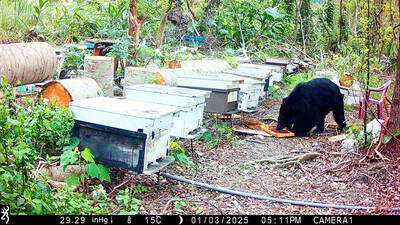The Bureau of Health Promotion said yesterday it would ask the National Communications Commission (NCC) to look into the option of penalizing stations that broadcast cartoons with regular scenes of characters smoking.
Bureau Director-General Chiu Shu-ti (邱淑媞) said the bureau found in a survey that cartoons topped other television programs in terms of the frequency of showing smoking.
The survey also found that sports programs and movies about police or teachers often contained such scenes.
Chiu offered examples including the Japanese TV cartoons One Piece, Hiraku’s Go and Naruto (火影忍者), as well as TV series Police et Vous (波麗士大人) and the professional wrestling program Smack Down.
The survey found that, on average, smoking scenes appeared at least once every two episodes. Several cartoons had images of smokers in every episode.
“Parents may be caught off guard because they might not expect images of smokers to appear in cartoons,” Chiu said. “Because cartoons and television series are aired daily at set schedules, children and teenagers may gradually see the images of smokers as acceptable and eventually start smoking. The government needs to take this matter seriously and address it in a more aggressive manner.”
The bureau also said in a statement that while Article 22 of the Tobacco Hazard Prevention Act (菸害防制法) states that images of smoking “shall not be particularly emphasized in television programs, drama or theatrical performances, audio-visual singing and professional sports events,” the act does not specify any penalty.
The bureau said the three major media laws — the Satellite Broadcasting Act (衛星廣播電視法), the Broadcasting and Television Act (廣播電視法) and the Cable Television Act (有線電視法) — include penalties for programs that impair the physical or mental health of children.
The bureau will ask the NCC to look into programs that frequently show smoking and determine a penalty for them.
Jason Ho (何吉森), director of the NCC’s communication content department, said the commission would have to turn the cases over to an independent panel to review their content and determine if they impair the physical or mental health of children.
He said the NCC might consider inviting representatives from the bureau to make their case, however, it had not received formal notice yet from the bureau.
“This matter involves judging different values,” Ho said.
“The smoking scenes may be placed in the plots as part of the producers’ creativity. The Bureau of Health Promotion may have its own thoughts on the matter, but we have to consider various factors. Wouldn’t it be strange to completely ban images of smoking?” he said.

SHIPS, TRAINS AND AUTOMOBILES: The ministry has announced changes to varied transportation industries taking effect soon, with a number of effects for passengers Beginning next month, the post office is canceling signature upon delivery and written inquiry services for international registered small packets in accordance with the new policy of the Universal Postal Union, the Ministry of Transportation and Communications said yesterday. The new policy does not apply to packets that are to be delivered to China, the ministry said. Senders of international registered small packets would receive a NT$10 rebate on postage if the packets are sent from Jan. 1 to March 31, it added. The ministry said that three other policies are also scheduled to take effect next month. International cruise ship operators

HORROR STORIES: One victim recounted not realizing they had been stabbed and seeing people bleeding, while another recalled breaking down in tears after fleeing A man on Friday died after he tried to fight the knife-wielding suspect who went on a stabbing spree near two of Taipei’s busiest metro stations, Taipei Mayor Chiang Wan-an (蔣萬安) said. The 57-year-old man, identified by his family name, Yu (余), encountered the suspect at Exit M7 of Taipei Main Station and immediately tried to stop him, but was fatally wounded and later died, Chiang said, calling the incident “heartbreaking.” Yu’s family would receive at least NT$5 million (US$158,584) in compensation through the Taipei Rapid Transit Corp’s (TRTC) insurance coverage, he said after convening an emergency security response meeting yesterday morning. National

PLANNED: The suspect visited the crime scene before the killings, seeking information on how to access the roof, and had extensively researched a 2014 stabbing incident The suspect in a stabbing attack that killed three people and injured 11 in Taipei on Friday had planned the assault and set fires at other locations earlier in the day, law enforcement officials said yesterday. National Police Agency (NPA) Director-General Chang Jung-hsin (張榮興) said the suspect, a 27-year-old man named Chang Wen (張文), began the attacks at 3:40pm, first setting off smoke bombs on a road, damaging cars and motorbikes. Earlier, Chang Wen set fire to a rental room where he was staying on Gongyuan Road in Zhongzheng District (中正), Chang Jung-hsin said. The suspect later threw smoke grenades near two exits

The Forestry and Nature Conservation Agency yesterday launched a gift box to market honey “certified by a Formosan black bear” in appreciation of a beekeeper’s amicable interaction with a honey-thieving bear. Beekeeper Chih Ming-chen (池明鎮) in January inspected his bee farm in Hualien County’s Jhuosi Township (卓溪) and found that more than 20 beehives had been destroyed and many hives were eaten, with bear droppings and paw prints near the destroyed hives, the agency said. Chih returned to the farm to move the remaining beehives away that evening when he encountered a Formosan black bear only 20m away, the agency said. The bear